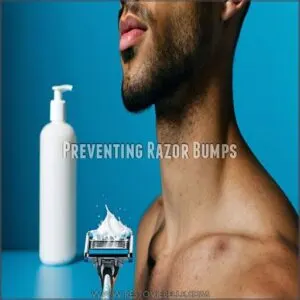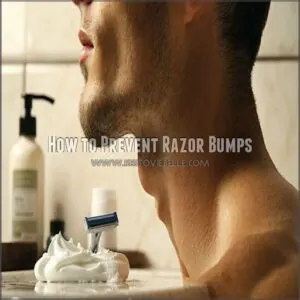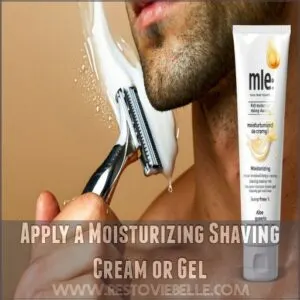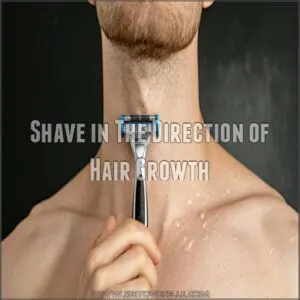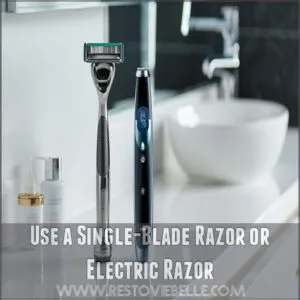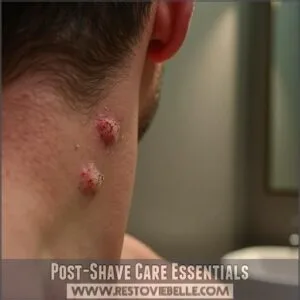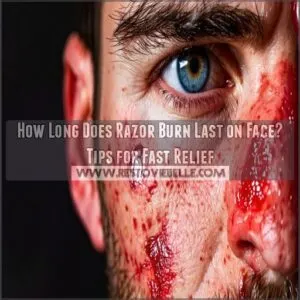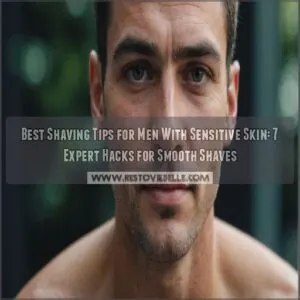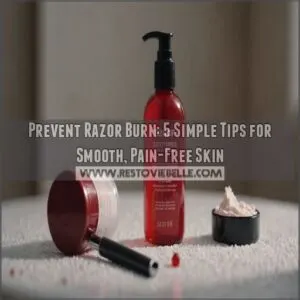This site is supported by our readers. We may earn a commission, at no cost to you, if you purchase through links.
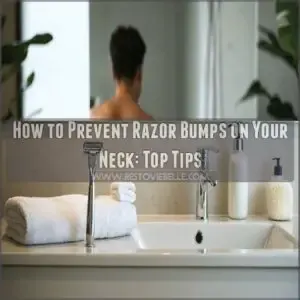 Preventing razor bumps on your neck starts with smart preparation and shaving habits.
Preventing razor bumps on your neck starts with smart preparation and shaving habits.
Use a warm towel before shaving to soften both skin and hair—think of it as a spa moment for your neck.
Exfoliate gently with a scrub or washcloth to clear away dead skin that traps hair.
Always shave in the direction of hair growth and opt for a single-blade or electric razor to avoid tugging at curly or coarse hair.
After shaving, soothe your skin with a cool compress and moisturize to lock in hydration.
Skip the alcohol-heavy aftershaves—they leave your skin dry and craving relief!
Table Of Contents
- Key Takeaways
- Preventing Razor Bumps
- How to Prevent Razor Bumps
- Pre-Shave Routine Tips
- Shaving Techniques Matter
- Post-Shave Care Essentials
- Frequently Asked Questions (FAQs)
- How do I get rid of razor bumps on my neck?
- What could be the cause of lumps in the neck?
- What causes neck razor bumps?
- How do I prevent razor bumps?
- Can camphor help a razor bump on the neck?
- How to get rid of razor bumps after a shave?
- Is it possible to prevent razor bumps when shaving?
- What causes razor bumps?
- What are the risk factors for razor bumps?
- How do doctors diagnose razor burns?
- Conclusion
Key Takeaways
- Prep your skin by using a warm towel to soften hair and exfoliate gently to remove dead skin and prevent ingrown hairs.
- Shave in the direction of hair growth with a single-blade or electric razor and avoid close shaves to reduce irritation.
- Soothe your skin post-shave with a cool compress, and skip alcohol-heavy aftershaves to prevent dryness.
- Apply a moisturizer with ingredients like aloe or glycerin to hydrate and lock in moisture for smoother, bump-free skin.
Preventing Razor Bumps
You can prevent razor bumps on your neck by following some simple, effective strategies. These tips cover pre-shaving, shaving techniques, and post-shave care to keep your skin smooth and bump-free.
Curly or Coarse Hair
Dealing with razor bumps? Your hair texture may be the culprit.
Curly or coarse hair tends to turn back into the skin, causing ingrown hairs and those pesky razor bumps.
This is especially true for those with naturally curly hair.
Managing coarse hair and finding curly hair solutions involves understanding your follicle care tips.
Preventing razor bumps starts with recognizing how your hair texture contributes to the problem.
To learn more about razor bump treatment options, consider consulting a dermatologist for personalized advice.
Frequent Shaving
While hair texture plays a role, shaving frequency greatly impacts razor bumps and neck irritation.
Too-frequent shaving, combined with poor razor maintenance, irritates skin, increasing your risk of razor bumps.
Adjust your shaving frequency. Understanding razor bumps causes is essential to prevent them.
Proper shave prep and avoiding frequent shaving are key to preventing razor bumps, especially with coarse hair. Give your skin a break!
Ingrown Hairs
Over-shaving can irritate your neck, but ingrown hairs themselves are a major razor bump culprit.
Ingrown hair causes include hair removal methods that cut hair below the skin surface. The hair curls back, creating skin inflammation, razor bumps, and neck irritation.
Proper follicle care and ingrown hair prevention are key to minimizing razor burn remedies and saying goodbye to those pesky bumps.
Genetic Propensity
Ingrown hairs aren’t just about technique.
Genetic factors, like your hair texture and skin sensitivity, play a role. For example, those of African descent with curly hair are more prone to pseudofolliculitis barbae (razor bumps).
Ethnic influence and hereditary traits related to hair follicle shape also contribute. So, while you can’t change your genes, understanding their impact helps you tailor your shaving routine.
How to Prevent Razor Bumps
While battling razor bumps can feel like a never-ending war, you can conquer them with the right strategy.
Razor bump prevention hinges on understanding your hair and skin.
Exfoliate your neck regularly to prevent ingrown hairs and reduce bumps.
Adjust your shaving frequency; less frequent neck shaving gives your skin time to recover.
Pay attention to your hair growth patterns, as shaving against them is a major culprit.
Understanding razor bump treatment is essential for effective prevention and management of razor bumps.
- Reduce bumps by understanding your hair.
- Prevent razor bumps with proper skin exfoliation.
- Shaving frequency matters more than you think.
- Neck shaving becomes easier with the right approach.
- Mastering shaving tips is key to smooth skin.
Pre-Shave Routine Tips
A good pre-shave routine is key to minimizing razor bumps, especially on your neck. It’ll prep your skin for a smoother shave and help prevent those pesky ingrown hairs.
Use a Warm Towel to Soften Skin
Starting with good skin preparation is key to preventing razor bumps on your neck.
Before you even think about grabbing your razor, try this: Drape a warm, damp towel over your beard area for a few minutes.
This warm compress acts like a mini-spa treatment, softening the hairs and making your skin more pliable.
This simple skin softening technique sets the stage for gentle exfoliation and helps prevent those pesky razor bumps from forming in the first place.
It’s shaving tips 101 for a smoother neck!
Exfoliate With a Gentle Scrub or Washcloth
After warming your neck, gently exfoliate to prevent razor bumps. This removes dead skin and preps your skin for a smooth shave.
Using a gentle neck scrub can be particularly effective in this process.
- Use a gentle scrub.
- Or, try a soft washcloth.
- Exfoliate your neck before shaving.
- This helps prevent ingrown hairs and skin irritation.
Apply a Moisturizing Shaving Cream or Gel
Once your skin’s prepped, reach for a quality moisturizing shaving cream or gel.
These products boost moisture levels, soften hair, and create a smoother razor glide.
Look for gel ingredients like aloe or glycerin—they hydrate sensitive skin and reduce razor bumps.
Understanding oily skin care is essential for an effective shave.
Skipping this step can leave your neck irritated, so don’t skimp on hydration before you shave!
Shaving Techniques Matter
How you shave plays a huge role in preventing razor bumps. Simple changes like shaving with the grain and skipping close shaves can keep your skin happier.
Shave in The Direction of Hair Growth
Paying attention to hair growth patterns is key to avoiding shaving bumps.
Always shave in the direction of hair growth to prevent razor bumps and irritation.
Understanding the hair growth cycle is important for effective shaving techniques.
Ignoring this advice can cause the blade to tug on out-of-alignment follicles.
Mastering shaving angles and maintaining proper skin tension helps you glide smoothly, reducing risks and keeping your neck bump-free.
Use a Single-Blade Razor or Electric Razor
Switching to a single-blade razor or electric razor can make a huge difference in preventing shaving bumps.
These reduce tugging and irritation. Using single blade razors can greatly improve the shaving experience.
Here’s why they help:
- Razor Maintenance: Fewer blades mean easier cleaning and less buildup.
- Blade Sharpness: Single blades stay sharper longer.
- Shaving Frequency: An electric razor’s gentler approach allows more flexibility between shaves.
Avoid Close Shaves
Resist the urge for that super close shave.
Leaving a bit of stubble (think the length of a grain of sand) can prevent razor bumps on your neck.
This tiny bit of hair texture acts as a buffer, preventing the razor blade sharpness from irritating your skin.
Adjusting your shaving frequency and skin preparation can also help prevent razor bumps.
A less aggressive blade angle also minimizes irritation.
Post-Shave Care Essentials
You’ve mastered the art of shaving, but the battle against razor bumps isn’t over yet.
Proper post-shave care is essential to soothe your skin and prevent those pesky bumps from forming on your neck.
Apply a Cool Compress to Soothe Skin
A cool compress works wonders for razor burn relief.
Grab a clean cloth, soak it in cold water, and gently press it against your neck for instant soothing skin care.
Cooling skin tips like this reduce irritation, calm redness, and ease razor bumps.
Cold therapy benefits include shrinking blood vessels, which minimizes swelling—simple, effective skin relief methods for post-shave care, providing instant soothing and skin care.
Use an Aftershave to Prevent Razor Bumps
After calming your neck with a cool compress, grab an aftershave to seal the deal.
It’s not just about smelling great—aftershaves bring real perks like razor burn relief and bump prevention. Look for ingredients like aloe vera or witch hazel for skin soothers.
To further reduce irritation, understanding shaving bump causes is essential for effective prevention.
Follow these steps:
- Pat skin dry.
- Apply gently.
- Avoid alcohol-heavy formulas.
- Let it absorb.
Apply a Moisturizer to Hydrate Skin
Don’t skip moisturizer—it’s like a drink of water for your neck, especially after shaving.
Hydrating creams soothe sensitive skin, reduce razor bumps, and lock in moisture.
Pick facial moisturizers with aloe or glycerin for dry skin remedies.
Using a neck moisturizer can provide essential hydration and protection.
Skin hydration tips: apply while your neck’s damp to trap water.
Your smooth, bump-free skin will thank you.
Frequently Asked Questions (FAQs)
How do I get rid of razor bumps on my neck?
Treat razor bumps by exfoliating gently to release trapped hairs, applying aloe vera or tea tree oil to soothe irritation.
Using a warm compress is also beneficial for the healing process.
Avoid shaving for a few days to let your skin heal.
What could be the cause of lumps in the neck?
Lumps in the neck can stem from swollen lymph nodes due to infections like colds or sore throats, cysts, thyroid issues, or even tumors.
If they persist or cause concern, see a doctor promptly.
What causes neck razor bumps?
Razor bumps on your neck happen when shaved hairs curl back and grow into the skin.
This irritates the area, leading to redness, swelling, and bumps.
Curly hair, frequent shaving, and improper technique worsen the problem.
How do I prevent razor bumps?
Keep your skin hydrated and exfoliated before shaving.
Use a sharp single-blade razor, shave in the hair’s growth direction, and skip close shaves.
Finish with soothing gel or balm to avoid irritation.
Can camphor help a razor bump on the neck?
Camphor can soothe razor bumps by easing irritation and reducing redness.
Apply a cream or ointment containing camphor directly to the area.
It’s a gentle option, but skip it if your skin feels sensitive.
How to get rid of razor bumps after a shave?
Around 60% of men experience razor bumps after shaving.
To fix it, try a warm compress to soothe irritation, exfoliate gently to free trapped hairs, and apply aloe vera gel or a tea tree oil solution.
Is it possible to prevent razor bumps when shaving?
Yes, you can prevent razor bumps.
Shave with a fresh, single-blade razor, follow hair growth direction, and avoid close shaves.
Prep your skin with exfoliation and shaving gel, and always moisturize after.
What causes razor bumps?
Razor bumps happen when shaved hairs curl back or grow sideways into your skin, causing irritation.
They’re more common with curly or coarse hair, frequent shaving, or using techniques that cut hair too short.
What are the risk factors for razor bumps?
Is your hair curling back like a stubborn boomerang?
Coarse or curly hair, frequent shaving, improper techniques, and shaving against hair growth increase razor bump risks.
Men with sensitive skin and African descent are especially prone.
How do doctors diagnose razor burns?
Doctors usually examine your skin to spot symptoms like redness, bumps, or irritation.
They might use a dermoscope to rule out other conditions and suggest treatments, ensuring you get relief without second-guessing the problem.
Conclusion
Picture yourself with smooth, bump-free skin—no irritation in sight.
Preventing razor bumps on your neck takes a little effort but pays off big.
Stick to a warm towel prep, exfoliate gently, and always shave in the direction of hair growth.
Swap harsh razors for a single blade or electric option, and don’t skip post-shave care with moisturizers and cool compresses.
With these tips, you can say goodbye to razor bumps and hello to confident, irritation-free shaves!
- https://www.gillette.co.in/en-in/tips-for-shaving/shaving-tips/shaving-rash-on-neck
- https://www.businessinsider.com/how-to-avoid-razor-burn-when-shaving-neck-2019-8
- https://www.gq.com/story/prevent-razor-burn
- https://www.medicalnewstoday.com/articles/318235
- https://www.menshealth.com/grooming/g25775931/how-to-get-rid-of-razor-bumps-men/
